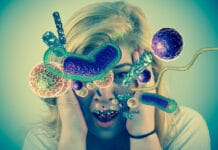I am a seasoned dental hygienist. I am also a mother and a grandmother, and I like the title of “Memaw” much better. I know exactly how parents feel when a child is experiencing pain or discomfort. Parents want solutions and answers on how to alleviate or prevent the pain, especially when infants and small children are unable to verbalize what is bothering them. One example of this discomfort early in life is the teething process.
Those pearly whites protruding through the gingiva cause their fair share of problems with our little people. Biological issues can include a mild fever, changes in eating habits, increased drooling, some congestion, and just overall fussiness of the child.1 This is not a new problem, as teething has been around literally forever. However, I have discovered that the solutions chosen by parents are changing.
A mother recently brought in her child for a routine prophylaxis. A two-year-old child in a stroller accompanied them. The youngest child was wearing a necklace, and the mother informed me that it was a “teething necklace.” It is not the too-big-for-the-mouth rubber squishy pieces that kids can gnaw and chew on to help alleviate the itchy painful process of teething. The necklace was a piece of jewelry; small, amber beads made into a necklace.
A ‘Natural’ Necklace?
Truthfully, I was rather perplexed by this piece of jewelry for babies. How does it work? What is it? Is it safe? Through some online research, I learned these necklaces are especially popular with the homeopathic and all-natural communities. They are readily available through boutiques, Etsy, and big-box stores such as Amazon. The prices range from $8 to $20. Proponents of the necklace made of Baltic amber claims it helps with the pain of teething by releasing succinic acid that is supposed to be absorbed through the child’s skin and acts as an analgesic.
What is Baltic amber? Formed over 45 million years ago, Baltic amber is an organic substance, a fossil resin produced by pine trees that grew in northern Europe and the Baltic Sea.2 Baltic amber has been used since ancient times for jewelry and ornaments, as an ingredient in perfumes, and in folk medicine for its healing properties.
Amber consists of 79 percent carbon, 10.5 percent hydrogen, and 10.5 percent oxygen. The claim is that succinic acid found in the amber is the oldest and most profound resource for the acid and it is emitted when warmed by the skin and produces an analgesic effect as it is absorbed to help support general well-being and support the immune system.
Sounds great, right?
A Closer Look
Despite the claims, there is no scientific proof that these pieces of jewelry work for the intended purpose. According to Dr. Aaron Celestian, an associate curator of mineral sciences at the Natural History Museum of Los Angeles, beads made from real Baltic amber do, indeed, contain succinic acid. But the acid cannot be absorbed into the skin from a necklace.3
“From a chemical point of view, you have to be able to release the succinic acid from the amber, and that only happens at very high temperatures, around 400 degrees Fahrenheit.” Those temperatures obviously will not be reached just being worn around the neck of a child. Some manufacturers and proponents also contend that the amber beads reduce gum inflammation and drooling, but there’s no evidence to back these claims either.
So, they are not proven to be helpful, but are they harmful? Yes!
In 2018, an 18-month-old died of strangulation after falling asleep wearing an amber necklace.4 The FDA has since issued a strong warning to the public regarding the amber necklaces stating, “The risks of using jewelry for relieving teething pain include choking, strangulation, injury to the mouth and infection. Choking can happen if the jewelry breaks and a small bead enters the child’s throat or airway. Strangulation can occur if a necklace is wrapped too tightly around the child’s neck or if the necklace catches an object such as a crib. Other concerns include injury to the mouth or infection if a piece of the jewelry irritates or pierces the child’s gums.”
Safer Alternatives
I personally believe there is not enough evidence for any benefit with the amber necklaces, while the choking risks are hard to ignore. Other much safer ways to help with the discomfort of teething include:
- Large plastic toys that can be chewed on
- Cold or frozen cloths
- Frozen bananas or apples were a personal favorite of my kids, and it also gives the bonus of a healthy snack.
- Massaging a baby’s or toddler’s gums can be helpful
- If the discomfort is extreme, you can ask the pediatrician or pediatric dentist for a mild pain reliever
Growing pains are going to happen. I just urge you to choose wisely when considering a way to help with the teething process.
Need CE? Click Here to Check Out the Self-Study CE Courses from Today’s RDH!
Listen to the Today’s RDH Dental Hygiene Podcast Below:
References
- Ardakani, A.A. What Are Teething Amber Necklaces and Do They Really Work. Little Heros of Orange County Pediatric Dentistry Blog.
- Baltic Amber – Gold of the North. Amber Artisans. Retrieved from https://www.amberartisans.com/whatisamber2.html
- Hunter, L.L. The Trouble with Amber Teething Necklaces. New York Times Parenting. July 23, 2019. Retrieved from https://parenting.nytimes.com/childrens-health/amber-teething-necklaces
- Joy, K. Amber Teething Necklaces Linked to Toddler’s Death. Patheos. December 21, 2018. Retrieved from https://www.patheos.com/blogs/withoutacrystalball/2018/12/amber-teething-necklaces-linked-to-toddlers-death/












